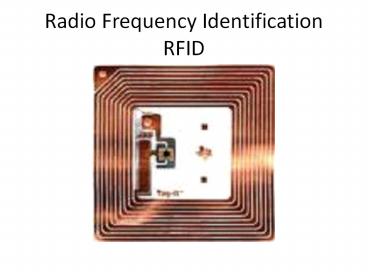Radio Frequency Identification RFID - PowerPoint PPT Presentation
Title:
Radio Frequency Identification RFID
Description:
light up the world it must be negociated by all ... For this we need neutral spaces that can bring opposites ... Growing up, Bruce Springsteen. Two projects in ... – PowerPoint PPT presentation
Number of Views:342
Avg rating:3.0/5.0
Title: Radio Frequency Identification RFID
1
Radio Frequency Identification RFID
2
(No Transcript)
3
(No Transcript)
4
(No Transcript)
5
The Internet of Things
- At the moment only logistics and retail is
- thinking about this. But it is too important. If
we - light up the world it must be negociated by all
- stakeholders artists, poets, citizens,
youngsters, - old people, parents, children,
6
For this we need neutral spaces that can bring
opposites together in dialogue
- A place to discuss, make prototypes and give
advice to governments and companies - Both the internet and the internet of things
- Media policy has become a policy of
infrastructures and access
7
Waag Society
- Education, Culture, Health, Public Domain
8
- Collaborations between
- Users Groups/Society
- Designers
- Programmers
- Artists Scientists
- h gt Demo
- Die
9
(No Transcript)
10
(No Transcript)
11
Design for social friction
- SEARCH JAM DEBATE RADIO RADICAL When they said
sit down, I stood up - Growing up, Bruce Springsteen
- Two projects in
- development which investigate and produce tools
for citizenship for both youth and - policy agents. Two crucial terms are light
communities and design for social friction. In - Designing for social friction Exploring
ubiquitous computing as means of cultural - interventions in urban space the authors claim
that social friction is articulated as a - critical position, which could be applied as a
strategy for design. In the recent decade - we have seen many attempts in community projects
and policies at large to design trust. - The conditions in the European cities and
specifically the disciplining measures by - governments, the tendency to police situations
that call for dialogue shows that this - design for trust has lead to the current
stalemate between an evergrowing call for more - repression and indifference.
- (Rune Huvendick Jensen Tau Ulv Lenskjold IT
University of Copenhagen www.itu.dk )
12
Climate Change
- We look up and all around us ice is melting,
strange flies appear on our - doorsteps, ants we've never had before roam our
houses, plants wake up - among new neigbours. Those among us who pack
their clothes for summer - and winter are continuously at loss as of where
to put what. The environment - itself is changing themes, as if the scenes in
her play are becoming slightly of. - And we feel it. We care. Yet we act as if are
quite helpless. In not being able to - identify clear agency we seem to freeze in fear
as we feel we can not do - do - as in act change - anything.
13
Future heritage (imagine ic, bibi panhuizen)
- It is clear that we do not need more data, more
statistics, more graphs when we - can feel the change in the winds of climates. It
is also clear that we do not need - more visualizations or mappings, or renderings of
any kind to begin to argue - that we might understand better. We do. Words are
pushing themselves - forward in particular sentences, bridges and
narrative, it seems. Weary of the - challenge of the pun, the riposte, the clever
retorte, stream of consciousness - for theory, we begin to look for fresh air.
- Future heritage (imagine ic, bibi panhuizen)
14
Artists can be the pattern.
- Sharon Fernandez - artist and institutional
change strategist - says the artistic - response to the credit crisis and climate change
is primarily about the challenge - to match the 'pluralities without' diversity of
cultures, religions, everyday - practices with the 'pluralities within'
ourselves. In her view, artists do not map - patterns but ARE the pattern. Through
articulation of the need for the - recognition of the pluralities within, we wish to
take discussions and practical - encounters at TM09 beyond the realization that we
lack certain morals. We aim - to fuse imaginative modes of confronting the
'pluralities without' with a genuine - attempt to formulate an ethics of how we might
live with the pluralities within.
15
(No Transcript)































